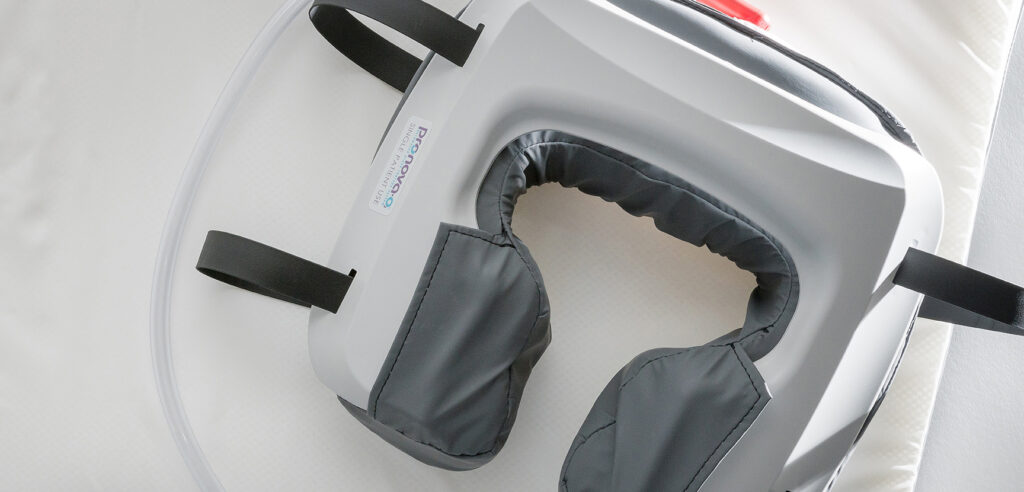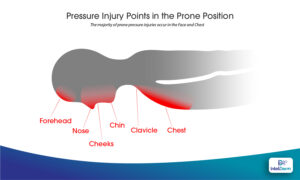
Prone Position and Unique Areas at Risk for Pressure Injury
While prone positioning as an intervention has been established as a standard of care for patients with acute respiratory failure,1 a common adverse event and potential barrier to the intervention is development of pressure injuries.2 The risk for pressure injury in patients who require the prone position is due to multiple contributing factors such as low oxygenation, immobility, moisture, poor nutrition, and prolonged duration of time in one position (prone position).3 To mitigate risk related to some of these factors, many different interventions have been proposed including the services of a Wound Care Nurse, establishing protocols and training, and pressure injury prevention strategies.
 The National Pressure Injury Advisory Panel (NPIAP) has created a tool for facilities discussing pressure injury prevention strategies for the prone position. It identifies key areas at risk for pressure injury such as the forehead, chin, cheeks, nose, clavicle, chest, knees, and dorsal feet, among others.4 Among these areas at risk, the majority (76%) of pressure injuries occur on the face and chest.3 The NPIAP document then highlights interventions such as using a pressure redistributing surface, application of prophylactic dressings, and managing moisture on the face with oral care and application of certain ointments.4
The National Pressure Injury Advisory Panel (NPIAP) has created a tool for facilities discussing pressure injury prevention strategies for the prone position. It identifies key areas at risk for pressure injury such as the forehead, chin, cheeks, nose, clavicle, chest, knees, and dorsal feet, among others.4 Among these areas at risk, the majority (76%) of pressure injuries occur on the face and chest.3 The NPIAP document then highlights interventions such as using a pressure redistributing surface, application of prophylactic dressings, and managing moisture on the face with oral care and application of certain ointments.4
These were the only strategies available to manage moisture accumulation on the face and chest prior to the development of the Pronova-O2™ Automated Prone Therapy System and the InteliDerm™ Powered Skin Protection System. InteliDerm provides clinicians with the ability to provide key pressure injury interventions in the prone position such as pressure redistribution and moisture management never previously available in one system. With InteliDerm, clinicians now have a new tool at their disposal to combat the risk for pressure injury in the prone position for the face and chest.
The Pronova-O2 Automated Prone Therapy System provides a safe and efficient method for positioning critically ill patients. INQUIRE NOW to request a demo for your facility! For additional information on automated prone positioning, please visit turnmedical.com or call 1-855-275-8876.
Refer to Pronova-O2 Instructions for Use for full prescribing information including risks.
- Papazian, L., Aubron, C., Brochard, L. et al. Formal guidelines: management of acute respiratory distress syndrome. Ann. Intensive Care 9, 69 (2019). https://doi.org/10.1186/s13613-019-0540-9
- Fourie, A., Ahtiala, M., Black, J., Hevia, H., Coyer, F., Gefen, A., LeBlanc, K., Smet, S., Vollman, K., Walsh, Y., & Beeckman, D. (2021). Skin damage prevention in the prone ventilated critically ill patient: A comprehensive review and gap analysis (PRONEtect study). Journal of Tissue Viability, 30(4), 466–477. https://doi.org/10.1016/j.jtv.2021.09.005
- Johnson, C. et. al. (2022). Pressure Injury Outcomes of a Prone-Positioning Protocol in Patients with COVID and ARDS. American Journal of Critical Care, 31(1), pp. 34-41.
- National Pressure Injury Advisory Panel. (2020). Pressure Injury Prevention – PIP Tips for Prone Positioning. Retrieved March 29, 2022 from https://cdn.ymaws.com/npiap.com/resource/resmgr/press_releases/NPIAP_PIP_Tips_for_Proning.pdf






